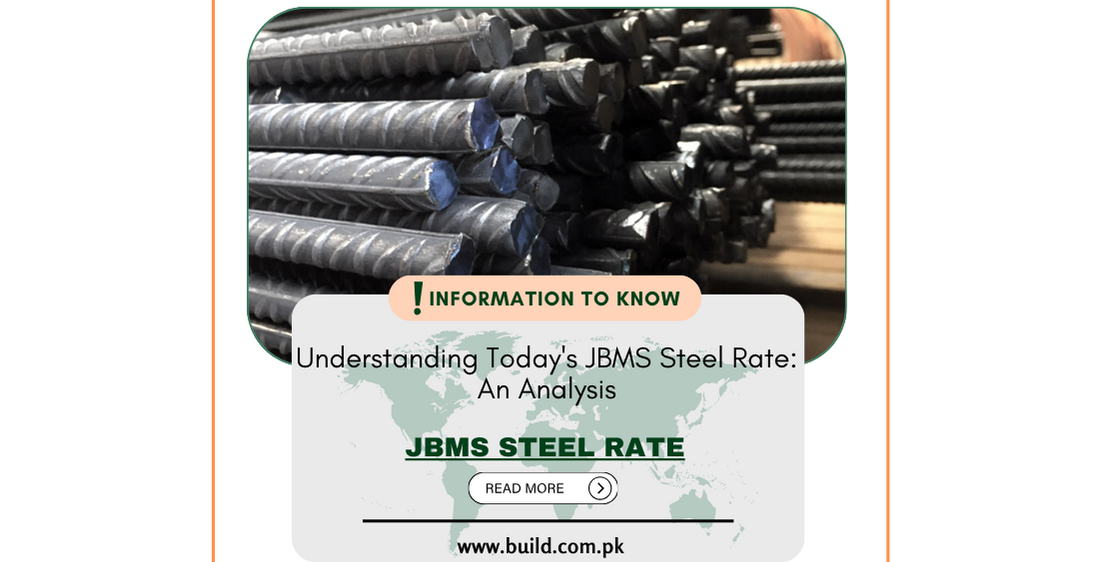Understanding Today's JBMS Steel Rate: An Analysis

Introduction:
In the dynamic world of construction and manufacturing, staying updated with the latest steel rates is crucial for informed decision-making and cost estimation. JBMS steel, renowned for its quality and reliability, plays a significant role in various industries, including construction, infrastructure development, and manufacturing. In this detailed blog, we'll delve into the factors influencing JBMS steel rates today, how they are determned, and what implications they have for stakeholders across different sectors.
Understanding JBMS Steel:
JBMS steel, also known as Joist,
Beam, and Mild Steel, is a type of structural steel commonly used in
construction projects for its strength, durability, and versatility. It
encompasses a range of steel products, including beams, channels, angles,
plates, and bars, desined to provide structural support and stability in
buildings, bridges, and infrastructure projects. JBMS steel is manufactured
through processes such as hot rolling, cold rolling, and fabrication to meet
specific dimensional and mechanical properties required for various
applications.
Factors Influencing JBMS Steel Rates Today
Several factors
contribute to the fluctuation of JBMS steel rates on any given day. Thesefactors include:
Global Steel Demand:
Global demand for steel, influenced by
economic growth, infrastructure development, and manufacturing activities,
impacts the prices of JBMS steel. High demand leads to increased prices, while
low demand may result in price reductions.
Raw Material Costs:
The prices of raw materials used in steel
production, such as iron ore, coal, and scrap metal, directly affect the
production costs of JBMS steel. Fluctuations in raw material prices due to
supply and demand dynamics, geopolitical factors, and currency fluctuations can
impact JBMS steel rates.
Market Speculation:
Speculative trading, investor sentiment,
and market dynamics also influence JBMS steelrates. Speculators, traders, and
investors may buy or sell steel futures contracts based on their expectations
of future price movements, leading to short-term fluctuations in steel prices.
Government Policies and Regulations:
Government policies,
trade tariffs, import/export regulations, and taxation policies can affect the
prices of JBMS steel by influencing supply and demand dynamics, trade flows,
and production costs.
Exchange Rates:
Fluctuations in exchange rates between
currencies can impact the cost of imported raw materials, equipment, and
machinery used in steel production, thereby influencing JBMS steel rates.
Determining Today's JBMS Steel Rate
Today's JBMS steel rate
is determined by various factors, including:
Steel Market Indexes:
Steel market indexes, such as the
S&P Global Platts Steel Index, Metal Bulletin, and CRU Group, provide
benchmarks for steel prices based on industry data, market trends, and trade
volumes.
Steel Futures Contracts:
Steel futures contracts traded on
commodities exchanges, such as the London Metal Exchange (LME) and Chicago
Mercantile Exchange (CME), provide price transparency and hedging opportunities
for steel producers, consumers, and traders.
Industry Surveys and Reports:
Industry surveys, reports, and
market analyses conducted by research firms, industry associations, and
consulting firms provide insights into steel market trends, demand-supply
dynamics, and price forecasts.
Real-time Pricing Platforms:
Real-time pricing platforms and
online marketplaces, such as SteelOrbis, MetalMiner, and Steel Benchmarker,
aggregate pricing data from steel producers, distributors, and buyers to
provide up-to-date information on JBMS steel rates.
Implications for Stakeholders
The fluctuation of JBMS steel
rates today has several implications for stakeholders across different sectors:
Construction Industry:
Builders, contractors, and developers
must factor in fluctuations in JBMS steel rates when estimating project costs,
bidding for contracts, and managing budgets for construction projects.
Manufacturing Sector:
Manufacturers of fabricated steel
products, machinery, equipment, and consumer gods must consider the impact of
steel price changes on production costs, pricing strategies, and profit
margins.
Steel Producers and Suppliers:
Steel producers, mills, and
distributors must monitor market trends, adjust production levels, and manage
inventory to respond to changes in JBMS steel rates and maintain profitability.
Investors and Traders:
Investors and traders in the steel
industry, including hedge funds, commodity trading firms, and steel futures
traders, may capitalize on price fluctuations in JBMS steel by engaging in
speculative trading, hedging strategies, and arbitrage opportunities.
Conclusion:
Today's JBMS steel rate is influenced by a
complex interplay of factors, including global demand, raw material costs,
market speculation, government policies, and exchange rates. Understanding the
determinants of JBMS steel rates and their implications for sakeholders is
essential for navigating the dynamic steel market, managing risks, and making
informed decisions. Whether you're involved in construction, manufacturing,
trading, or investment, staying informed about today's JBMS steel rate is
crucial for success in the steel industry.









